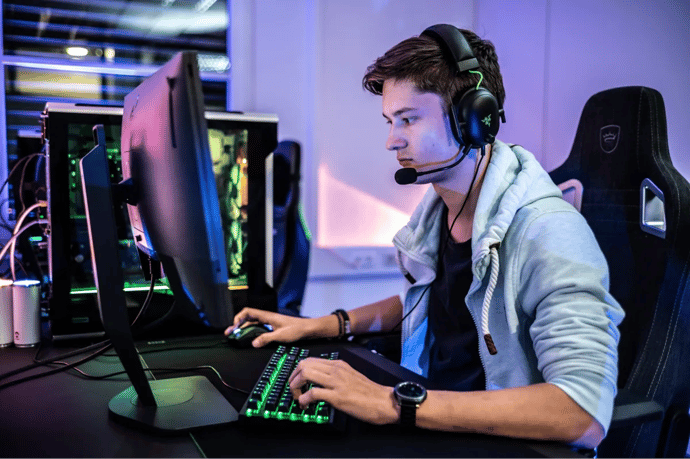
NBA 2K League Betting Guide: How Real Basketball Strategy Translates to Esports Wagers

The NBA 2K League blends traditional basketball strategy with the unpredictability of esports. For bettors, it’s a world where real-life basketball smarts can provide a serious edge—if you know what to look for. This guide breaks down how authentic, brick and mortar basketball concepts translate to NBA 2K League betting, how to evaluate teams and players, and what separates smart wagers from guesswork.
Real Basketball Strategy Matters in Virtual Games
Though it’s a digital court, the core of NBA 2K League gameplay revolves around traditional basketball principles.
Each team in the league follows offensive and defensive systems that mirror professional basketball. Motion offenses, pick-and-rolls, full-court presses—these aren't just visual aesthetics, they affect pace, possession count, scoring distribution, and player tendencies. A bettor familiar with basketball tactics already holds a significant advantage in evaluating how eTeams may clash in a series.
For example, NBA teams with dominant guards running high pick-and-rolls tend to favor fast-paced shootouts. They often lead in assists, three-point attempts, and turnovers. Meanwhile, squads focusing on defensive switches and half-court sets generally push games under the point total. Knowing these tendencies helps sharpen over/under predictions and spread bets in the virtual world.
Understanding how spacing and tempo play out in a virtual setting isn’t optional—it’s essential. Teams that clog the paint and rotate on defense well can consistently disrupt high-usage scorers. When a bettor sees a matchup between a disciplined team and a one-dimensional scorer, it should raise red flags for betting props or head-to-head odds.
Archetypes and Matchups Drive Outcomes
Every player in the NBA 2K League uses a customized archetype. These archetypes—like 3&D wings, two-way slashing guards, or stretch bigs—determine a player’s strengths and limitations.
Just like in real basketball, certain archetypes match up poorly against others. A small point guard who thrives in isolation may struggle against a defensive build with high steal ratings and lateral quickness. Bettors who understand these nuances can make sharper bets on individual stat props, such as points, steals, or assists.
Matchups also influence how teams use their offensive sets. If an opponent's power forward lacks perimeter defense, the offense might run more pick-and-pops to exploit that gap. On the betting side, that could signal increased three-point attempts or a shift in scoring distribution. Looking at these matchup details before placing a wager separates a casual bet from a well-reasoned one.
More importantly, knowing which players dominate at their position helps identify value in moneyline bets. If a team has a lockdown defender at point guard and the opponent relies heavily on that position for scoring, there’s a clear opportunity to fade the favorite or grab plus-value on the underdog.
Team Chemistry and Coaching Define the Intangibles
Unlike traditional esports, NBA 2K League relies heavily on team chemistry and off-ball movement. Players must coordinate defensive rotations, communicate in real time, and adjust on the fly—just like in real basketball. The best teams exhibit trust and anticipation, even without the crowd noise or physical presence of a live court.
Coaching in NBA 2K League also plays a pivotal role. Coaches design plays, study film, and make adjustments based on matchups. Betting on teams with established systems and a proven coaching staff offers more stability than backing a team with raw talent and poor discipline.
Some teams stick to rigid systems that dominate weak opponents but falter against counter-strategies. Others adapt dynamically across a series. Bettors should look at series history, mid-game adjustments, and in-game communication breakdowns—especially in playoff settings.
For example, a team that repeatedly gets caught in transition after missed threes might not just be undisciplined—it may point to a deeper flaw in spacing or rotation. That’s a tangible signal to reassess the team’s ability to cover a spread or stay under a total.
Tempo, Scoring Efficiency, and Turnovers Are the Hidden Metrics
While betting lines reflect headline stats like points per game or win-loss records, the true indicators of team performance lie deeper.
Tempo—measured in possessions per game—impacts totals more than scoring averages. A team with a fast pace but low field goal efficiency can still drive high-scoring games because of sheer shot volume. Bettors eyeing over/unders should always factor in tempo alongside shooting splits.
Scoring efficiency—particularly true shooting percentage and points per possession—offers a more accurate view of offensive output. Some teams may score 70+ points regularly but rely on unsustainable shot selection. If a team wins by trading threes but lacks rebounding and second-chance opportunities, the betting risk increases against disciplined defenders.
Turnover differential is another undervalued metric. High turnover teams often struggle in tight matchups and lose close games due to rushed possessions or bad decisions. Watching recent trends—like a team averaging more turnovers after a roster shift—can uncover smart fade opportunities.
Combining these stats provides a clearer view of how a team actually performs under pressure. It’s not just about who wins—it’s about how they play.
How to Apply These Concepts to Betting Markets
Turning all this into actionable wagers requires discipline and awareness of market behavior.
Most NBA 2K League wagers follow the same logic as traditional basketball bets—but not every sportsbook lists esports markets yet. To get a feel for how these bets work, it helps to look at the structure of reputable online sportsbooks like FanDuel, where NBA markets are clearly laid out. From spreads and totals to player props and live bets, those formats provide a strong reference point for how similar markets could apply to competitive 2K, even if they're not currently offered.
Moneyline betting benefits most from matchup insights. A team with strong archetype counters and a high-IQ defense can upset a favorite simply by neutralizing its star. Watching how a team handled similar opponents in the past gives bettors a roadmap for upsets.
Point spread bets depend heavily on tempo and in-game momentum. Teams that score in bursts but can’t close out leads are unreliable on large spreads. Meanwhile, grind-it-out teams that slow down opponents might cover small spreads even in losses.
Prop bets—especially player stats—reward bettors who study archetypes and matchups. If a point guard is facing a top-tier perimeter defender, under on points or assists may hold better value than backing the total. Props also allow bettors to exploit gaps before sportsbooks adjust.
Live betting adds another layer. Observing whether a team responds to pressure or folds after a run can help bettors hedge or double down. Seeing a team get repeatedly burned in transition could indicate a lack of adjustments—a perfect spot to live-bet the over or fade their second-half spread.
Always review post-game stat sheets and VODs (videos on demand). Betting on the NBA 2K League isn’t just about stats—it’s about trends, reactions, and rhythm. Spotting those patterns early gives you a long-term edge.
Mastering the Virtual Court Starts with Respecting the Game
Esports often get dismissed as a novelty, but betting on the NBA 2K League is as much about basketball acumen as it is about gaming intuition. The best bettors bring both to the table.
Respect the strategy. Study the matchups. Follow the trends. There’s value hidden behind the avatars—if you know where to look.

Elen Stelmakh est une personne créative qui se consacre à l'avancement de la culture des jeux vidéo par le biais d'articles et de conceptions visuelles. En tant qu'auteur d'EGamersWorld et concepteur d'un site Web de jeux à temps plein, Elen ne se contente pas de créer du contenu, elle y insuffle également de l'énergie et de la créativité.
 Casse-tête de la Porte Bleue des Arc Raiders : Résoudre toutes les énigmesLes puzzles Arc Raiders Blue Gate exigent des mouvements précis, des itinéraires rapides et une parfaite connaissance des interrupteurs cachés, des piles et des intérieurs chronométrés. Ce guide couvre toutes les solutions avec des informations claires et factuelles.
Casse-tête de la Porte Bleue des Arc Raiders : Résoudre toutes les énigmesLes puzzles Arc Raiders Blue Gate exigent des mouvements précis, des itinéraires rapides et une parfaite connaissance des interrupteurs cachés, des piles et des intérieurs chronométrés. Ce guide couvre toutes les solutions avec des informations claires et factuelles. Quoi de neuf dans Winter Offensive : Battlefield 6 Mise à jour 1.1.3.0Winter Offensive 1.1.3.0 apporte une carte enneigée, une nouvelle arme et un gameplay amélioré à Battlefield 6.
Quoi de neuf dans Winter Offensive : Battlefield 6 Mise à jour 1.1.3.0Winter Offensive 1.1.3.0 apporte une carte enneigée, une nouvelle arme et un gameplay amélioré à Battlefield 6. Date et heure des Game Awards 2025 dans le monde entierLa date et l'heure de TGA 2025 ont été confirmées pour un spectacle mondial en direct diffusé sur les principales plateformes.
Date et heure des Game Awards 2025 dans le monde entierLa date et l'heure de TGA 2025 ont été confirmées pour un spectacle mondial en direct diffusé sur les principales plateformes. StarLadder Budapest Major 2025 - Playoff Pick'em : Prédictions et opinionsStarLadder Budapest Major 2025 Playoff Pick'Em guide : pronostics de bracket, opinions d'experts et conseils clés pour vous aider à gagner la pièce de diamant tant convoitée.
StarLadder Budapest Major 2025 - Playoff Pick'em : Prédictions et opinionsStarLadder Budapest Major 2025 Playoff Pick'Em guide : pronostics de bracket, opinions d'experts et conseils clés pour vous aider à gagner la pièce de diamant tant convoitée.


